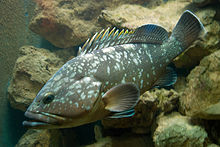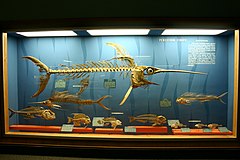Perciformes
| Perciformes Temporal range:
| |
|---|---|

| |
Dusky grouper (Epinephelus marginatus)
| |
| Scientific classification | |
| Domain: | Eukaryota |
| Kingdom: | Animalia |
| Phylum: | Chordata |
| Class: | Actinopterygii |
| Clade: | Percomorpha |
| Order: | Perciformes Bleeker, 1863 |
| Type species | |
| Perca fluviatilis Linnaeus, 1758
| |
| Suborders | |
|
See text | |
Perciformes (/ˈpɜːrsɪˌfɔːrmiːz/), also called the Acanthopteri, is an order or superorder of ray-finned fish in the clade Percomorpha. Perciformes means "perch-like". Among the well-known members of this group are perch and darters (Percidae), sea bass and groupers (Serranidae).[1]
Taxonomy
Formerly, this group was thought to be even more diverse than it is thought to be now, containing about 41% of all
Evolution
The earliest fossil perciform is the extinct serranid Paleoserranus from the Early Paleocene of Mexico, but potential records of "percoids" are known from the Maastrichtian, including Eoserranus, Indiaichthys, and Prolates, although their exact taxonomic identity remains uncertain.[4][5]
Characteristics
The
Taxonomy
Classification of this group is controversial. As traditionally defined before the introduction of


|
References
- ^ "Perciform - Form and function". Encyclopedia Britannica. Retrieved 14 February 2019.
- ^ ISBN 978-0-471-25031-9.
- ISBN 978-1-118-34233-6. Archived from the originalon 8 April 2019. Retrieved 24 December 2020.
- ISSN 0895-9811.
- ^ Kriwet, Jürgen; Arratia, Gloria; López-Arbarello, Adriana; Parmar, Varun; Prasad, Guntupalli (1 January 2004). "Late Cretaceous-Paleocene percomorphs (Teleostei) from India - early radiation of perciformes". Recent advances in ….
- ^ Froese, Rainer, and Daniel Pauly, eds. (2015). "Perciformes" in FishBase. August 2015 version.
- ^ "ADW: Perciformes". animaldiversity.ummz.umich.edu. Animal Diversity Web.
- ^ ISBN 978-1-118-34233-6. Archived from the originalon 8 April 2019. Retrieved 20 February 2020.
- PMID 28683774.
